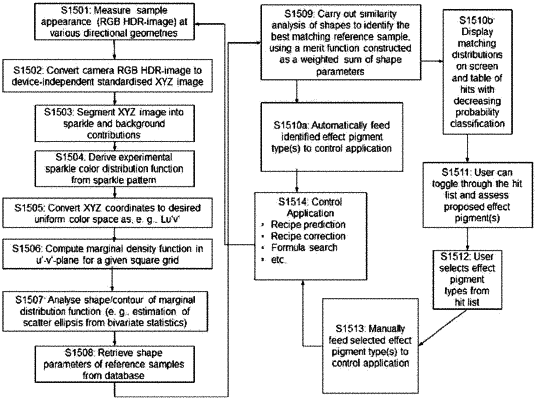| CPC G01J 3/504 (2013.01) [G01J 3/463 (2013.01); G06T 7/41 (2017.01); G06T 7/60 (2013.01); G06T 7/90 (2017.01)] | 13 Claims |

|
1. A computer-implemented method for identifying an effect pigment, the method comprising executing, on at least one processor of at least one computer, steps of:
a) acquiring sample image data describing a digital image of a layer comprising a sample effect pigment;
b) determining, based on the sample image data, sparkle point data describing a sample distribution of sparkle points defined by the digital image, wherein each sparkle point in the sample distribution is described by three coordinates in a three-dimensional color space having a coordinate defining lightness and two coordinates defining chromaticity of the sparkle points;
c) determining, based on the sparkle point data, sparkle point transformation data describing a projection of the sample distribution onto a two-dimensional color space, wherein the two-dimensional color space is defined as a chromaticity plane and the projection has a direction perpendicular to the chromaticity plane, wherein the chromaticity plane is parallel to two axes of the three-dimensional color space that define the two chromaticity coordinates and perpendicular to an axis that defines the lightness coordinate of the three-dimensional color space;
d) determining, based on the sparkle point transformation data, sparkle point distribution geometry data describing a geometry of the sample distribution in the two-dimensional color space, said geometry of the sample distribution representing a geometric shape of a marginal density function of the sample distribution in the two-dimensional color space;
e) acquiring a reference distribution geometry database, wherein each entry in the reference distribution geometry database comprises reference distribution geometry data describing a geometry of a reference distribution of sparkle points in the two-dimensional color space, said geometry of the reference distribution representing a geometric shape of a marginal density function of the reference distribution in the two-dimensional color space;
f) acquiring a reference distribution association database, wherein each entry in the reference distribution association database describes an association between a reference distribution associated with an entry in the reference distribution geometry database and an identifier of the reference distribution, the identifier defining the identity of a reference effect pigment for which the reference distribution has been generated;
g) comparing the sparkle point distribution geometry data to each entry of the reference distribution geometry database to find a reference distribution whose geometry is similar to the geometry of the sample distribution; and
h) determining, using the reference distribution association data, sample pigment identity data describing an identity of the sample effect pigment, the identity of the sample pigment being the identity of the reference pigment associated with the reference distribution whose geometry is similar to the geometry of the sample distribution.
|